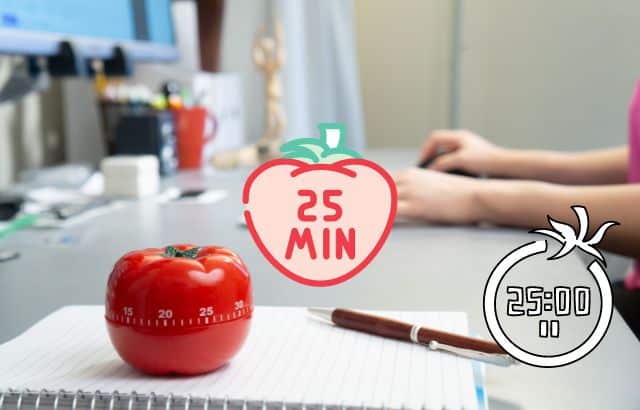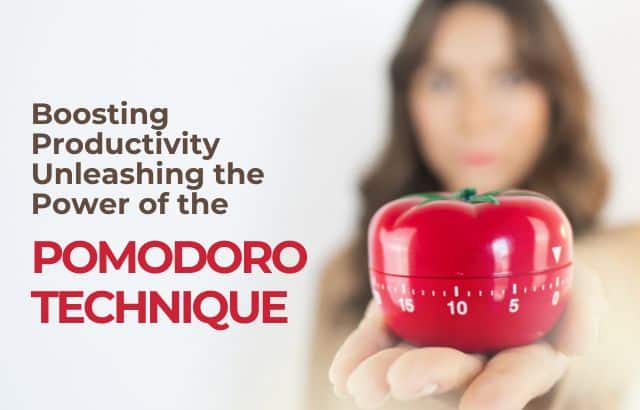Pomodoro Technique Benefits- In the fast-paced world we live in, where distractions abound and the demands of daily life seem to escalate without respite, finding an effective strategy to enhance productivity is paramount. Enter the Pomodoro Technique, a time management method that has gained widespread popularity for its simplicity and efficacy. Imagine a humble kitchen timer shaping the way people work and dramatically increasing their productivity. Let’s delve into the fascinating journey of the Pomodoro Technique, exploring its origins, mechanics, and the compelling statistics that validate its impact on productivity.
Table of Contents
Origins and Basics:

The Pomodoro Technique was developed by Francesco Cirillo in the late 1980s. The name “Pomodoro,” which means “tomato” in Italian, was inspired by the tomato-shaped kitchen timer that Cirillo initially used. The technique follows a straightforward process: work on a task for 25 minutes, known as one Pomodoro, and then take a short break. After completing four Pomodoros, take a more extended break. The key is to maintain focus during the short work intervals, fostering a sense of urgency and preventing burnout.
Statistics on Pomodoro’s Impact:
Increased Focus and Concentration
A study conducted by the University of California, Irvine, found that regular breaks can significantly improve focus and prevent mental fatigue. The Pomodoro Technique’s structured approach aligns with these findings, providing a systematic way for individuals to maintain concentration throughout their workday.
Enhanced Task Completion
According to a survey on the Pomodoro Technique’s official website, 90% of respondents reported an increase in task completion and overall productivity after adopting the technique. The structured time intervals create a sense of urgency, helping individuals prioritize tasks and complete them more efficiently.
Reduced Procrastination
The American Psychological Association reports that procrastination affects up to 20% of the population. The Pomodoro Technique’s incremental approach helps combat procrastination by breaking tasks into manageable chunks, making them less overwhelming and more approachable.
Improved Work-Life Balance
A study published in the Journal of Applied Psychology indicates that effective work time management strategies can lead to improved work-life balance. The Pomodoro Technique emphasizes scheduled breaks, ensuring individuals can recharge and maintain a healthy balance between work and personal life.
Implementing the Pomodoro Technique can lead to substantial improvements in focus, productivity, and overall well-being.
Implementing the Pomodoro Technique:
To integrate the Pomodoro Technique into your daily routine, start by identifying your tasks and breaking them into manageable segments. Set a timer for 25 minutes and focus solely on the task at hand. Once the timer rings, take a 5-minute break. After completing four Pomodoros, take a more extended break of 15-30 minutes.
Productive Strategies Using the Pomodoro Technique
The Pomodoro Technique is a simple yet effective time management method that can enhance focus and productivity across various tasks. Below are specific applications for writing projects, studying for exams, managing work tasks, learning new skills, and tackling household chores.
1. Work on a Writing Project

Steps:
- Outline: Begin by creating an outline to organize your thoughts.
- Draft: Allocate time for drafting each section.
- Edit: Set time aside for editing your work.
- Proofread: Finally, dedicate a session to proofreading.
Pomodoro Sessions:
- Duration: 25 minutes of focused writing.
- Break: 5-minute break after each session.
- Longer Break: After four Pomodoros, take an extended break to recharge.
2. Study for Exams

Steps:
- Divide Material: Break down your study material into manageable topics or chapters.
- Focused Study: Tackle one topic at a time.
Pomodoro Sessions:
- Duration: 25 minutes of concentrated studying.
- Break: 5-minute break to relax your mind.
- Longer Break: After four sessions, take a longer break to consolidate your learning.
3. Manage Email and Tasks at Work
Steps:
- Prioritize Tasks: Identify urgent emails and tasks.
- Focus Time: Allocate specific time slots for handling each.
Pomodoro Sessions:
- Duration: 25 minutes to manage emails or tasks.
- Break: 5-minute break to recharge.
- Repeat: Continue this cycle to enhance productivity.
4. Learn a New Skill or Language
Steps:
- Break Down Learning: Divide the learning process into specific exercises or lessons.
- Practice Sessions: Focus on one skill at a time.
Pomodoro Sessions:
- Duration: 25 minutes of practice.
- Break: 5-minute break to absorb new information.
- Longer Break: After four sessions, take a break to reinforce your understanding.
5. Household Chores
Steps:
- Identify Tasks: List chores that need to be done.
- Set Goals: Determine what you want to accomplish in each session.
Pomodoro Sessions:
- Duration: 25 minutes of focused cleaning or organizing.
- Break: 5-minute break to relax.
- Repeat: Use this method to make chores less daunting and more manageable.
By applying the Pomodoro Technique to these areas, you can enhance your focus, productivity, and overall well-being. Breaking tasks into smaller sections helps you avoid feeling overwhelmed, allowing for steady progress and effective time management.
Why does this tomato trick work?
- It breaks big tasks into smaller bites, so they feel less overwhelming. It’s like eating a giant pizza one slice at a time!
- It helps you focus like a laser beam because you know you only have to work for 25 minutes. No more getting distracted by every little thing!
- It trains your brain to work in focused bursts, which is actually how our brains work best.
- Short breaks help you stay fresh and avoid burnout. It’s like giving your brain a little spa treatment!
- Celebrating each finished pomodoro feels awesome! It’s like getting a high-five from your inner cheerleader.
Conclusion:

The Pomodoro Technique stands as a testament to the transformative power of simplicity. By incorporating short, focused bursts of work and regular breaks, individuals can experience heightened concentration, increased productivity, and improved work-life balance. As we navigate the demands of our modern lives, the Pomodoro Technique remains a beacon of efficiency, helping us make the most of our time while fostering a sustainable and balanced approach to work. Try it for yourself, and unlock the potential within each Pomodoro.










